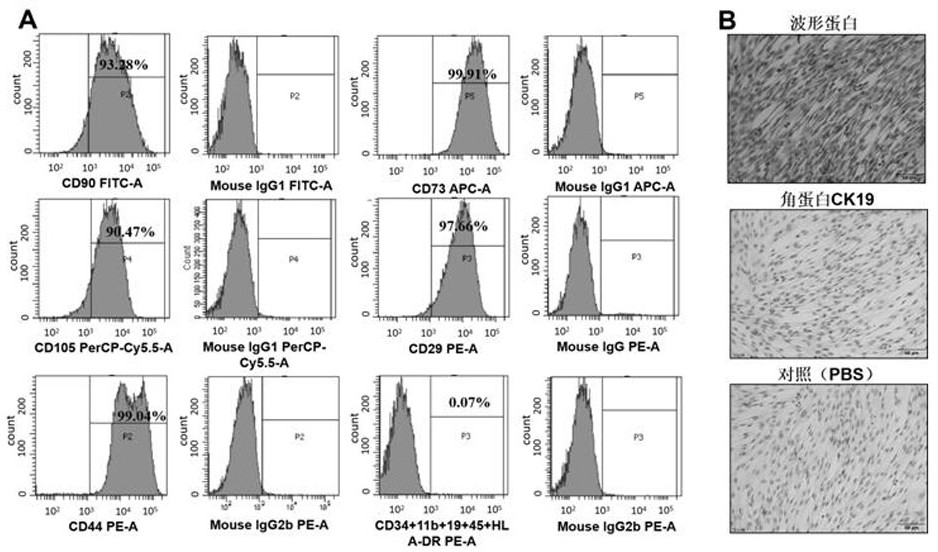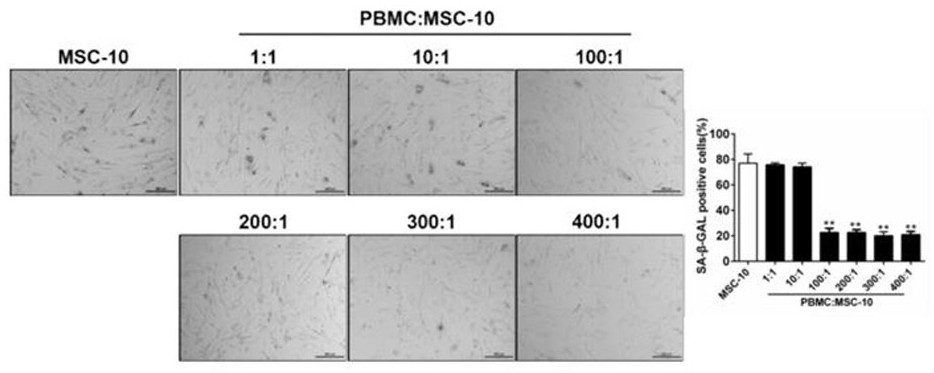Method for resisting human mesenchymal stem cell aging and enhancing stem characteristics of human mesenchymal stem cells
A stem cell and aging technology, applied in embryonic cells, animal cells, vertebrate cells, etc., can solve the problems that the regulation of aging stem cells has not been reported, and achieve the effects of improving self-renewal ability, delaying aging, and promoting expression
- Summary
- Abstract
- Description
- Claims
- Application Information
AI Technical Summary
Problems solved by technology
Method used
Image
Examples
Embodiment 1
[0036] Example 1: Isolation, culture and identification of human mesenchymal stem cells
[0037] The amniotic tissue was stripped from the fresh placenta of healthy full-term cesarean section, and the D-PBS solution containing 1% double antibody (final concentration of penicillin: 100 IU / mL, streptomycin: 100 IU / mL, freshly prepared before use) was used Rinse off residual blood and mucus repeatedly. Press 1 cm 2 After the amniotic membrane is cut into pieces, the amniotic membrane is divided into 50 mL centrifuge tubes, and about 2 times the volume of the amniotic membrane tissue is added with 0.05% trypsin digestion solution containing 0.02% EDTA-2Na, and it is digested in a constant temperature water bath at 37 °C at 185 rpm. For about 30 min, filter with a 300-mesh stainless steel filter, discard the supernatant, and repeat the above steps once. Wash the digested amniotic tissue once with D-PBS solution containing 1% double antibody, add an equal volume of 0.5 mg / mL type ...
Embodiment 2
[0038] Example 2: Separation of human peripheral blood immune cells
[0039] Peripheral blood was taken from fresh normal physical examination population and diluted with an equal volume of sterile D-PBS. Add an appropriate amount of Histopaque-1077 to a 15 mL centrifuge tube, slowly add an equal volume of blood diluted with sterile D-PBS along the tube wall, centrifuge at 2000 rpm for 20 min; absorb the middle buffy coat layer, add an equal volume of sterile D-PBS , 1500 rpm, and centrifuge for 10 min; wash with sterile D-PBS repeatedly once, discard the supernatant; suspend the cell pellet in low-sugar DMEM medium containing 10% FBS, and obtain PBMC immune cells. Using the property that peripheral blood mononuclear cells (PBM) are easy to adhere to and grow on plastic cell culture plates, PBM and peripheral blood lymphocytes (PBL) are separated from the above-mentioned PBMC.
Embodiment 3
[0040] Example 3: Comparison of the reversal effect of co-culture of PBMCs with different cell ratios and aging MSCs on aging cells
[0041] Human amniotic MSCs continuously expanded to passage 9 in vitro and exhibiting replicative senescence were taken, and 10 4 The density per well was inoculated in a 12-well cell culture plate, and freshly isolated PBMCs were added after 16 h, wherein the density of PBMCs was 10 4 , 10 5 , 10 6 , 2×10 6 , 3×10 6 and 4×10 6 / well, the ratios of PBMC and MSC co-cultured cells were 1:1, 10:1, 100:1, 200:1, 300:1 and 400:1, respectively. After PBMCs and MSCs were co-cultured for 72 h, the number of positive senescent MSCs was detected by β-galactosidase staining. The results show( figure 2 ), the rate of β-galactosidase-positive cells in the control group was (77.07±7.23)% in the aging MSC cultured to the 10th passage (hereinafter referred to as "MSC-10"), when PBMC:MSC-10=1:1 or 10 :1, compared with the aging control group, the positi...
PUM
| Property | Measurement | Unit |
|---|---|---|
| diameter | aaaaa | aaaaa |
Abstract
Description
Claims
Application Information
 Login to View More
Login to View More - R&D
- Intellectual Property
- Life Sciences
- Materials
- Tech Scout
- Unparalleled Data Quality
- Higher Quality Content
- 60% Fewer Hallucinations
Browse by: Latest US Patents, China's latest patents, Technical Efficacy Thesaurus, Application Domain, Technology Topic, Popular Technical Reports.
© 2025 PatSnap. All rights reserved.Legal|Privacy policy|Modern Slavery Act Transparency Statement|Sitemap|About US| Contact US: help@patsnap.com



